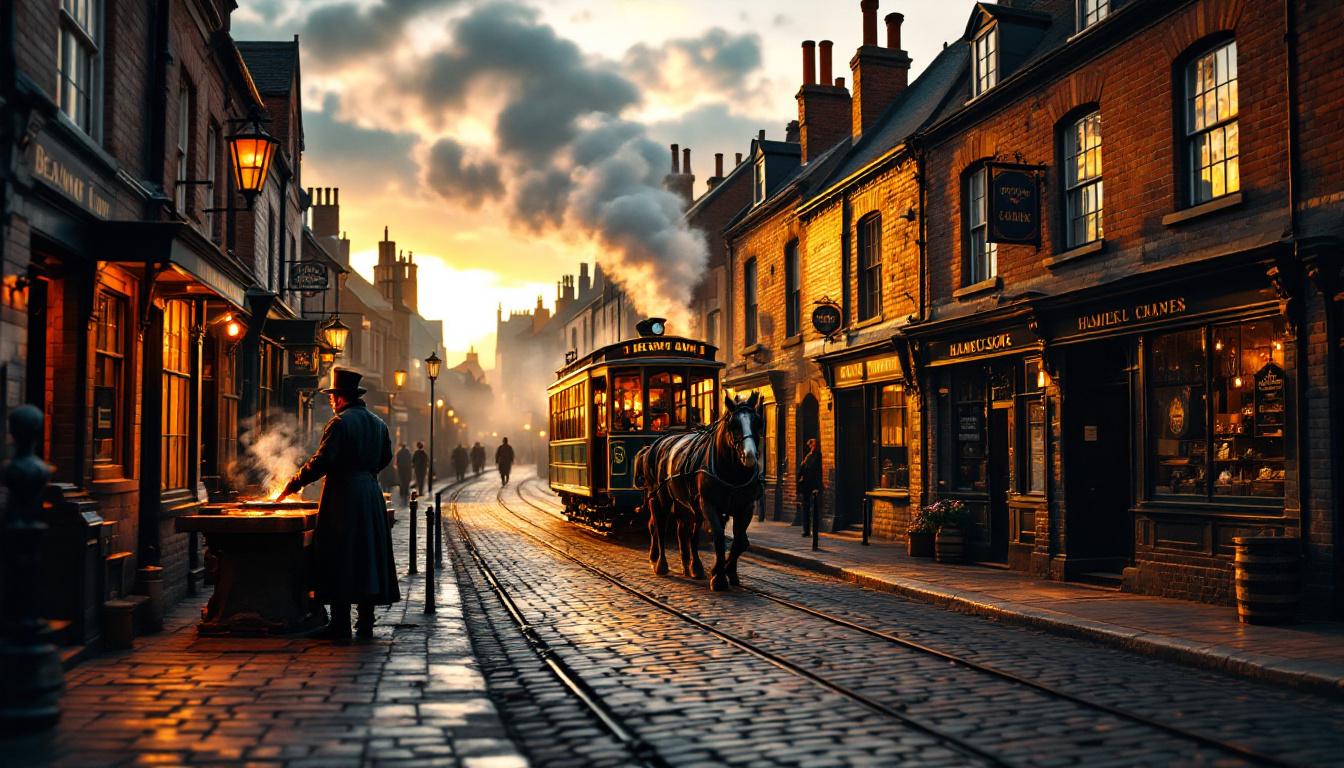Walking through Beamish Museum feels like stepping through a time portal into Victorian England. This living village recreates how London’s working-class neighborhoods looked and felt 150 years ago, before modern tourism transformed Britain’s capital into something unrecognizable.
Unlike London’s sanitized heritage sites, Beamish preserves the authentic grit of 1820s-1950s industrial life. Local demonstrators still practice trades that vanished from London decades ago, working as Victorian shopkeepers, blacksmiths, and chemists using original techniques tourists never witness in major cities.
This 300-acre living museum in County Durham captures the soul of pre-modern Britain that London’s glass towers and chain stores have erased forever. Here, costumed locals don’t just perform—they live the trades their great-grandparents knew.
Victorian trades that disappeared from London still thrive here
Authentic craftspeople demonstrate forgotten skills
Watch master printers operate century-old printing presses at the 1913 newspaper office, using techniques London’s Fleet Street abandoned for digital efficiency. The scent of ink and metal transport fills authentic Victorian workshops where visitors can try traditional typesetting—an experience impossible in London’s modern media district.
Traditional shopkeepers serve customers Victorian-style
Step into Annfield Plain Co-operative where shopkeepers weigh loose tea and wrap purchases in brown paper, exactly as London’s corner shops operated before supermarkets arrived. These aren’t actors—they’re local volunteers preserving their grandparents’ retail traditions that London’s commercialization destroyed.
Streets recreate London’s lost working-class neighborhoods
Terraced houses show authentic Victorian family life
Francis Street’s 1900s terraced houses mirror London’s vanished East End neighborhoods, complete with coal fires, tin baths, and cramped bedrooms where entire families once lived. Unlike London’s gentrified Victorian conversions, these homes preserve the authentic hardships and simplicities of working-class life.
Cobblestone streets echo with period-correct sounds
Heritage trams clatter along original cobblestones transported from demolished Newcastle streets, creating the authentic soundscape London’s tarmac roads silenced forever. The clip-clop of shire horses and whistle of steam engines transport visitors to pre-automotive Britain that London’s traffic drowned out.
Community traditions London’s modernization eliminated
Seasonal celebrations follow Victorian calendars
Village festivals celebrate traditional harvest seasons and Victorian holidays exactly as London’s working communities once did, before commercialization transformed British celebrations into shopping events. Local families participate in authentic folk dances and games their London counterparts no longer remember.
Regional dialects preserve authentic Victorian speech
Costumed interpreters speak in authentic North East dialects that preserve Victorian pronunciation and vocabulary London’s standardization erased. Hearing “whey aye” and traditional greetings offers linguistic time travel to pre-BBC England when regional voices defined community identity.
Immersive experiences impossible in modern London
Hands-on workshops teach Victorian skills
Try traditional pottery throwing, bread baking, and heritage quilting techniques in working Victorian kitchens and craft rooms. London’s heritage sites offer guided tours—Beamish lets visitors actually practice the trades that built Britain’s industrial power.
Period transport systems visitors can actually ride
Board authentic 1900s electric trams and steam-powered buses that once connected London’s suburbs, now preserved in working condition. Unlike London’s transport museum displays, these vehicles still carry passengers through landscapes unchanged since Victorian times.
Beamish succeeds where London’s heritage preservation failed—it captures the authentic spirit of Victorian working life without commercial interference. Located just 30 minutes from Newcastle, this living village offers American visitors genuine British heritage experiences that London’s tourist crowds and high prices make impossible to find.
Visit during August-September 2025 when all outdoor exhibits operate fully, and traditional craft demonstrations run daily. Unlike London’s sanitized attractions, Beamish still honors the authentic trades and community spirit that built Victorian Britain—before progress erased them forever.
Essential planning for your Victorian time travel
How do I reach Beamish from major UK cities?
From London, take direct trains to Durham station (3.5 hours, £40-70), then bus 28A to Beamish (20 minutes). Much more accessible than London’s crowded heritage sites, with free parking and no advance booking required for most attractions.
What Victorian trades can visitors actually try?
Traditional printing, pottery, bread baking, and heritage quilting workshops run daily April-October. Unlike London’s demonstration-only exhibits, Beamish encourages hands-on participation in authentic Victorian craft techniques using original tools and methods.
Which exhibits showcase authentic London-style Victorian life?
The 1913 Town’s terraced houses and Co-operative store mirror London’s working-class neighborhoods exactly, while the newspaper office and chemist shop recreate high street businesses that London’s chain stores replaced decades ago.
